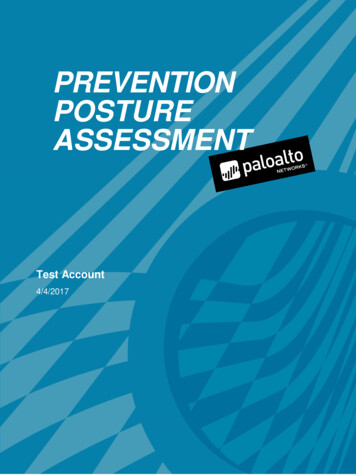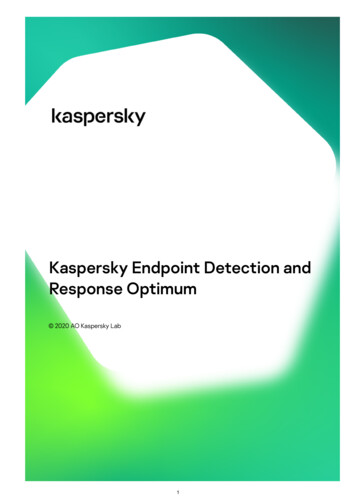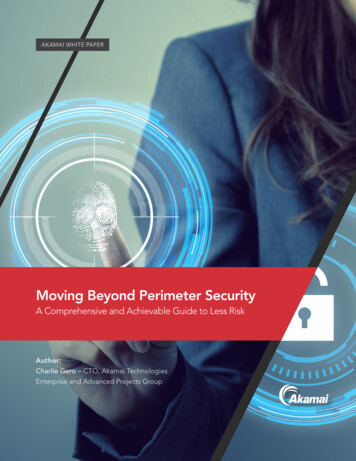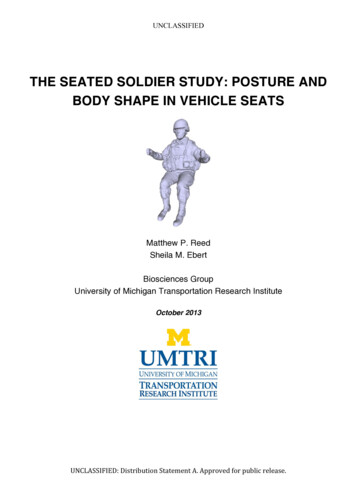
Transcription
PREVENTIONPOSTUREASSESSMENTTest Account4/4/2017 2017 Palo Alto Networks, Inc. Confidential and Proprietary1
Table of ContentsEXECUTIVE SUMMARY . 5Key Findings . 5Alignment of Findings with the Cyberattack Lifecycle . 5ENTERPRISE, MOBILITY AND SAAS - DELIVERY (PERIMETER BREACH) . 7Delivery (Perimeter Breach) Overview Chart . 7Key Findings . 7Recommendations. 8ENTERPRISE, MOBILITY AND SAAS - COMMAND AND CONTROL (OUTBOUND) . 10Command and Control (Outbound) Overview Chart . 10Key Findings . 10Recommendations. 11ENTERPRISE, MOBILITY AND SAAS - PRIVILEGED OPERATIONS AND RESOURCE ACCESS . 12Privileged Operations and Resource Access Overview Chart . 12Key Findings . 12Recommendations. 12DATA CENTER, CLOUD AND SAAS - EXFILTRATION . 13Exfiltration Overview Chart . 13Key Findings . 14Recommendations. 14ENDPOINT(WORKSTATIONS/SERVERS) - EXPLOITATION AND/OR INSTALL . 16Exploitation and/or Install Overview Chart . 16Key Findings . 16Recommendations. 17 2017 Palo Alto Networks, Inc. Confidential and Proprietary2
OPERATIONAL FUNDAMENTALS - OPERATIONS. 18Operations Overview Chart . 18Key Findings . 18Recommendations. 18OPERATIONAL FUNDAMENTALS - MAINTENANCE . 19Maintenance Overview Chart . 19Key Findings . 19Recommendations. 20OPERATIONAL FUNDAMENTALS - ANALYTICS . 20Analytics Overview Chart . 20Key Findings . 20Recommendations. 21 2017 Palo Alto Networks, Inc. Confidential and Proprietary3
Table of FiguresFigure 1: Controls by Grouping . 5Figure 2: Cyberattack Lifecycle . 6Figure 3: Delivery (Perimeter Breach) Overview Chart . 7Figure 4: Delivery (Perimeter Breach) Stage Gaps . 9Figure 5: Command and Control (Outbound) Overview Chart . 10Figure 6: Command and Control (Outbound) Stage Gaps . 11Figure 7: Privileged Operations and Resource Access Overview Chart . 12Figure 8: Privileged Operations and Resource Access Stage Gaps . 13Figure 9: Exfiltration Overview Chart . 13Figure 10: Exfiltration Stage Gaps . 16Figure 11: Exploitation and/or Install Overview Chart . 16Figure 12: Exploitation and/or Install Stage Gaps . 17Figure 13: Operations Overview Chart . 18Figure 14: Operations Stage Gaps . 19Figure 15: Maintenance Overview Chart . 19Figure 16: Maintenance Stage Gaps . 20Figure 17: Analytics Overview Chart . 20Figure 18: Analytics Stage Gaps . 21 2017 Palo Alto Networks, Inc. Confidential and Proprietary4
Executive SummaryKey Findings 38 out of 75 (50%) technological controls in place provide Full protection for the given stage of the cyberattacklifecycle 27 out of 75 (36%) technological controls in place providing Partial protection to some of the enterprise networkagainst stages of the cyberattack lifecycle. 10 out of 75 (13%) technological controls have No coverage provided for protection against attacks, according tothat component of the cyberattack lifecycle.Alignment of Findings with the Cyberattack LifecycleThe below stacked chart provides a high-level overview of the controls listed by group, along with the number of full,partial and no-coverage controls. Based on the details provided during the interview question-and-answer session,Test Account appears to be weak when protecting against risks and threats from the following areas of the attacklifecycle:While there are control weaknesses found in all areas reviewed, Test Account appears to have better protection inthe following areas: Delivery (Perimeter Breach) Command and Control (Outbound) Privileged Operations and Resource Access Exfiltration Exploitation and/or Install Operations Maintenance AnalyticsTotal Controls by &CPrivileged Op ExfiltrationFullPartialExploitationOperations MaintenanceAnalyticsNoneFigure 1: Controls by Grouping 2017 Palo Alto Networks, Inc. Confidential and Proprietary5
The Prevention Posture Assessment summarizes the business and security risks facing Test Account bydocumenting key security findings, along with recommendations. Palo Alto Networks worked with Test Account’sinformation technology and security staff to gather the data via an interview process.This report represents a snapshot of the Test Account environment at the time the questions were answered;The cyberattack lifecycle focuses on a series of techniques, methodologies and processes that attackers followwhen attempting to compromise or breach systems.Test Account can improve defense against successful attacks by implementing controls that stop attackers at anypoint in this lifecycle to prevent compromise and data loss via exfiltration. It should be noted that an attacker needsto be successful in all the steps of the attack lifecycle; whereas the defender, needs only to stop them at one stepfor the attack to be unsuccessful.This report documents prevention gaps and provides recommendations that teams can implement to improve thesecurity posture and reduce the risk to business tInstallCommandand ControlPrivilegedOperationsUnauthori zed AccessResourceAccessExfiltrationUnauthori zed UseFigure 2: Cyberattack Lifecycle 2017 Palo Alto Networks, Inc. Confidential and Proprietary6
Enterprise, Mobility and SaaS - Delivery (Perimeter Breach)This stage focuses on stopping attackers as they attempt to breach the network. Attackers succeed in this stage byreaching out in various ways to users. Many times, this part of the cyberattack lifecycle involves phishing or socialengineering techniques to trick the user into installing malicious files. Our analysis includes the traditionalarchitecture access points, as well as mobile or remote devices, SaaS-based resources, and shadow IT (a termoften used to describe information technology systems and solutions built and used inside organizations withoutexplicit organizational approval).Properly fielding all the capabilities available from Palo Alto Networks Threat Prevention protects across all threatvectors that attackers use to bypass the perimeter of the network – often the first line of defense.Delivery (Perimeter Breach) Overview ChartDelivery16%33%50%FullPartialNoneFigure 3: Delivery (Perimeter Breach) Overview ChartKey Findings IPS (All ports, inline, both sides of traffic) (1) IPS at all Internet Access Points: Current Posture is Block ofCritical/High Severity and Default Medium/Low/Informational IPS (All ports, inline, both sides of traffic) (2) IPS Extension for Remote Access: IPS extended out to laptopenvironment with an on demand setup URL Filtering (All ports) (4) Pro-Active Investigation of URL: Currently utilizing Bluecoat and correlation of malwareactivity thresholds for alerts Segmentation (Zones) (5) Zero Trust Model Adoption: Current user wireless and wired segmented behind internalfirewall and plans to move wireless to utilizing PVLANs during hardware refresh Anti-Malware (All ports and inline) (6) Perimeter Anti-Malware: Currently blocking via PANW anti-malware Sandboxing (All ports and inline) (7) Perimeter File-Sandboxing: Licensed version on client segmentation PANWfirewalls 2017 Palo Alto Networks, Inc. Confidential and Proprietary7
Sandboxing (All ports and inline) (8) File-Sandboxing extension for Remote Access: No MDM solution currently toenforce on-demand per-app vpn for off Wifi access Decryption (9) Decryption: Current decryption is done via the Bluecoat's only for user traffic User and Application Control (Layer 7) (11) Application Control at Internet Access Point: Some APP-ID rulescurrently in place for Perimeter User and Application Control (Layer 7) (12) User Control at Internet Access Point: Partial implementation of allowgroups on perimeter currently User and Application Control (Layer 7) (13) Identify and Control of Unknown Applications at Perimeter: Currentlynot identifying Unknown Applications on Perimeter User and Application Control (Layer 7) (14) Evasive Technologies Prevention: Currently utilizing URL filtering forblocking and minimal App Block List SaaS malware delivery protection (15) SaaS Application Anti-Malware: Currently no scanning of Malware inSanctioned SaaS Applications E-mail store and forward (16) Email Store/Investigate/Forward: Proofpoint implementation set for March Infrastructure Protection (Zones) (17) DoS and Reconnaissance Prevention: Akamai for DDoS protection andPANW thresholds set for DoS some alerts set for reconnaissance protection Hosted Service Protection (Internal Zones) (18) Limited Unwanted Network Activity: No current DoS Protectionrules utilizedRecommendations IPS (All ports, inline, both sides of traffic) (1) IPS at all Internet Access Points: Current Posture is Block ofCritical/High Severity and Default Medium/Low/Informational. Recommended Default Strict hasCritical/High/Medium to block; Review strategy to implement a block stance in current IPS for Medium severitythreats also. IPS (All ports, inline, both sides of traffic) (2) IPS Extension for Remote Access: IPS extended out to laptopenvironment with an on-demand setup; recommend moving to a always on configurati
Palo Alto Networks worked with Test Account’s information technology and security staff to gather the data via an interview process. This report represents a snapshot of the Test Account environment at the time the questions were answered; The cyberattack lifecycle focuses on a series of techniques, methodologies and processes that attackers follow when attempting to compromise or breach .











